ARTICLE

In 2005, A. Atanassov crafted a Tarot deck inspired by Gustav Klimt's paintings.
The deck was called The Golden Tarot because many of Klimt's paintings had been made with golden leaves fixed by heat, a millenary technique the painter frequently implemented in his works. And Atanassov, the famous decks illustrator, created one based on several of them, creating a very special card suit which seems to be out-of-time, as paintings do so.

Klimt was born in Austria in the second middle of the XIX c. (1862-1918, Cancer) although his works seem to belong to anorher time. They're plenty of allegories and symbolisms, far from idealization, with naked bodies of big sensuality and decadence. There's no trace of the Victorian Age in his compositions, which was a kind of split that even made him move away from the Academics and the Association of Austrian Artists, to joining others in the Wiener Sezession (Viena's Secession), an alternative and independent group he founded in 18971. The separation had been preceded by another one five years before, among Münich's artists, and one year later was followed by another one, among Berlin's artists.
Anyway, Secession did count on an official branch, Ver Sacrum (Sacred Springtime), a magazine edited between 1898 and 1903. The title was related to a romantic poem by Ludwig Uhland, and also to an ancient sesasonal rite in which, after a time period, young people were ordered to leave their city or tribe to found a new one. The rite was of a martial kind, since a new foundation usually involved battles to fight for. The cover of the first edition showed the roots of a flourishing tree, with branches holding the coats of arms of architecture, painting and sculpture, breaking the wooden container that had become too small for them. In the first pages, it could be read:

Youth's spirit, blowing in springtime... by which the present always becomes 'modernity', which is the fuel of artistic creation.
VS, 1898, Nº 1, p 5
Luckily, Klimt didn't leave theoretical discourses about his artworks, so he left us free to enjoy them out of categories and adscriptions. In fact, his paintings seem more modern than those called post-modern ones! Secession didn't set statements either and, instead, the members were closer to the Gesamtkunstwerk or "total artwork", gathering in a single synthesis typographies, graphic elements, illustrations and even white empty spaces.
Experimenting with linear geometric models and plain figures, the designs also displayed a mostly modular composition of fascinating contrasts. Naked figures, and other ones wearing widely painted and stamped clothes. Plain figures, with no perspective, in an iconic display, and natural faces of pale flesh. Different atmospheres created by different usages of gold: black borders make them more shining, in a kind of 3D effect, although they can also express an oppressive air when the illustration seems narrowed inside of that frame.
The members of Secession considered Pallas Athenea, the goddess of war, as the group's leading spirit, and in 1898 Klimt portrayed her along with her weapons in a painting of the same name, in which she wears a helmet and a cuirass in her chest.


Pallas Athenea - The Empress
In her right hand, she holds a sphere on which can be seen Nuda Veritas, the goddess of Truth and mother of Virtues. Behind her, a battle scene between Hercules and Triton the sea monster (symbol of rigidity and conservatism). Both are on a background of winding shapes seeming to include many tombstones. Atanassov depicted the goddess in card III The Empress, inside of a narrow space among golden and adorned columns, on a reddish background seeming to be active, alive, sizzling, sensed as a bit faraway fires. Athenea seems to be at the entrance of those fires, which are placed on the background battle of the painting.
Between 1899 and 1907, Klimt made three paintings for the ceiling of the Great Hall of Viena's University, although they were burnt in 1945 before nazi troops reach them. They were Jurisprudence, Medicine and Philosophy. Two figures in Jurisprudence inspired some cards: the man embraced by a pulp's arms, and the figure in the middle of a group drawn in the top border.



Jurisprudence - Justice - The Hermit
The man seems resigned, like giving up and concentrated on his world within. His own head is an extension of one of the pulp's eyes, and he's one of the main four figures not surrounded by hairs but himself (the pulp). The figure inspired card IX The Hermit, in which there's no extension and the pulp is gone, which radically changes the original meaning of the painting: the hermit is headed down, and Atanassov didn't include any other element to be identified with the classic lantern that usually guides him. The rest of the figures around the sea animal are wrapped in long hairs, which reach the borders and beyond, with spiralled snakes seeming ropes extended all along their bodies: they're a sad woman, an angry woman, and a sleeping woman, all wrapped and tied. They might be the same women depicted as The Gorgons in Hostile powers, the second part of a later work, Beethoven frieze (1902). But on this painting, the middle figure in the group of three on the top border background, holding a large sword, inspired card VIII Justice.
Medicine is alluded to in several cards. The central figure looks straightly, seems self-confident and skilled, and is Hygieia the Greek goddess of cleaning and healing. Behind her, a column of hunched naked people, sleeping, painful, with a skeleton showing half of its skull, and even a pregnant woman in the top right corner (the only other figure who looks straightly, although with a pleasant expression in her face). Another figure on the left side is specially separated from the rest, reaching out her arm as if not caring, in the same way a man reaches out his arm towards her.

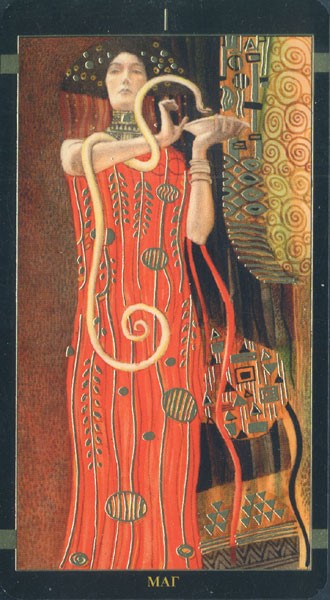
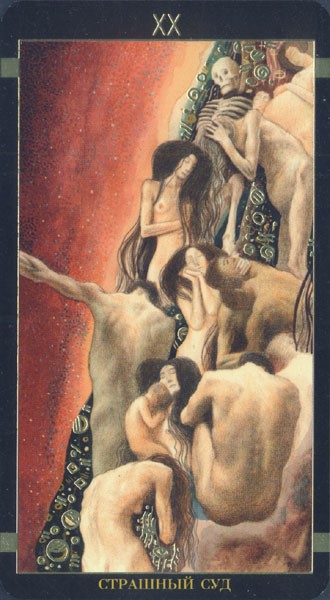

Medicine - The Magician - Judgement - The Chariot
Hygieia is referred to in card I The Magician although she's slightly looking at her right side and seems not too happy but strict about her methods and techniques. And the column of figures is not included in the card but in card XX Judgement, although Atanassov discarded several elements, specifically the painful faces and many lines that, in the painting, emphazise the sense of flesh and veins as well as the relevance of the skeleton in the whole composition. So, the card is entirely related to figures who are sleeping with death (even the pregnant woman): no pain, no pleasure. Whereas the figure remaining apart in the painting is referred to as the woman character in card VII The Chariot although, once again, the deck changed her a little bit. Atanassov placed her inside of a chariot, she's not careless anymore, and even holds up a stick: her hand doesn't fall, she's now on a path, with a more careful gesture, more self-oriented.
Philosophy transmits an atmosphere of progressive youth, detachment and freedom. In the bottom left area, a man as an old and tormented figure. In the top area, younger and amazed figures. On the right background, the traits of a calm face while being disintegrated. In the inferior area, a female face partially wrapped although clearly illuminated in a fantastic contrast with the rest of the lights, of strong white eyes, like those of Pallas Athenea, like a creature from another world.

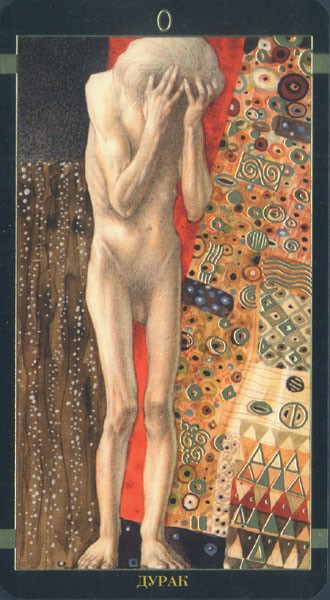
Filosophy - The Fool
However, Atanassov chose the decrepit and lamenting figure to represent card 0 The Fool, thus moving the card away from the spontaneous, "irrational" and unstructuring motion providing energy, lightness and out-of-series audacity.
In 1902, Klimt painted Beethoven frieze, an allegoric mural to make homage to the composer on his 75 th death anniversary, as well as to be part of Max Klinger's display of the musician's sculpture. Of 111.5 ft long, the mural is divided into three works on a white background. From left to right: Longing for happiness, Hostile powers and Hymn to joy.

In Longing..., enlarged figures are suspended in the air all along the horizontal top border, as if they were searching for, trying to reach out, although with eyes closed. Below, three naked figures and other three ones dressed up. The naked ones pay attention to those who wear clothes, and put their hands together, as imploring. The dressed up group is formed by an armoured knight, of a serious gesture and holding a sword, with two figures in the background: Ambition showing a bay leaves crown, and Compassion with a similar gesture to that of the sleeping figures the painter used to draw.
The knight is walking towards Hostile powers, the second part of the mural introducing Typhoeus, the mythical winged giant made of dragons and snakes, spitting fire and unleashing hurricanes and earthquakes. The ancient monster is represented by a huge winged hairy monkey, accompanied by nine figures distributed in three groups: three Gorgons and, showing up from behind Illness, Madness and Death, whereas on the right side are Lust, Intemperance and Voluptuousness. Farther to the right side is Sorrow, naked and wrapped in a fine black tulle, in a kind of a grid formed by serpents' tail skins.


Hostile powers - The Devil
Hostile powers inspired card XV The Devil, in which the monkey is not so large (it has no wings). Sorrow, whose presence extends almost half of the painting, has been replaced by Madness, with her arms in a dominant gesture, like in the classic The Devil card. All figures are sad, sober, and even their tits are too down! Pleasance has gone too, and The Gorgons are not expressing their characteristic malice but sorrow, inner pain, in a mixed identity with the missing Sorrow...
In the last area of the mural, Hymn to joy, Poetry is represented as a figure wearing a golden tunic and playing the zither. Along with her, the previous suspended and longing figures end their pathway of searching. Next, Klimt left a white empty space, followed by The Arts under the form of five female figures, one over the other one, two of them as if waiting, and the other three with extended arms, like the separated figure in Medicine did, with her reaching out and falling hand. Towards the right, nine figures, female ones either, float in the air like a choir. Near the end of the wall, two naked figures embrace each other, with feet and ankles wrapped in a skein-like thread.


Hymn to joy - The Sun
The couple might be on a yellow background, emitting flows from their heads, but the composition also suggests motion, in the opening of a kind of an arch on the background. The concept of opening is firstly displayed in the small floating elements seeming to fly in the air, composed of three borders that might expand or shrink the nuclear area, like modern gates. The idea is also suggested by two spheres in the superior area, like suns pushing the arch pieces to the outside (blue stripes). Atanassov was inspired by this section on the wall to design card XIX The Sun, although some additions and subtractions restrained the concept of opening, which was only continued by the floating elements. The couple is not tied by threads anymore, and both are on a background of yellow and dark lines which emphazises the emerging flow from the very union, so the arch opening is not referred to at all. Another change, also contrary to that motion, is the upper spheres depicted now inside of a circular figure, whose emanations are no longer blue and don't go beyond the limits of the perimeter.
Next year to Beethoven frieze, in 1903, Klimt composed Hope I, a painting that shows two groups of three figures each. The first group is at the front: one-side of a pregnant woman, naked, wearing a forget-me-not flowers crown, which also reaches the head of a dark shape that embraces her. The shape has claws, eyes and seems to be smiling (which is suggested by a slightly clearer lip-shaped color, a detail that creates an effect of our times, almost an emoji!).


Hope I - The World
Behind the woman, another figure completes the group: it's one side of the classic Death, in contrast with the woman's nudity since it wears a large blue tunic. The character is wrapped in the dark shape, too. The second group is in the top area in the background: the painful Illness, the wrinkled Old Age, and the pale Madness. The painting inspired card XXI The World, although Klimt's groups and identities are missing. The first group, in which the woman might easily be identified with the dark shape (they share the adornment and their sights perspective) and with Death (by contrast), is now alone. The second group is simply gone. Maybe the pregnant belly was related to the idea of populating the world, as a literal understanding of the card, but the absence of groups and multiple characters is far from the meaning of options, perspectives and chances classically associated to the cyclic motion indicated by the card. Anyway, Klimt's painting identities seem too specific to be attached to the card although are an accurate representation of the world's living conditions.
In Portrait of Fritza Riedler (1906), fusions and perspectives are added to contrasting backgrounds (sober rectangles, stained-glasses) and colors (cold ones in dress and seat, warm on the background).

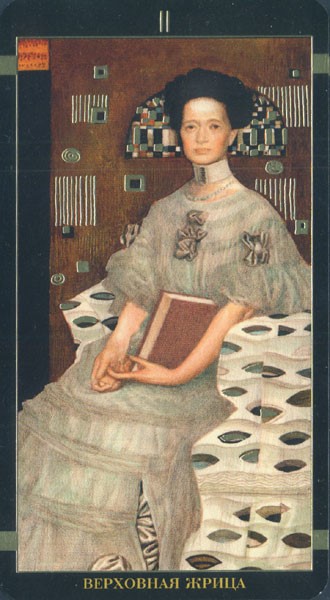
Portrait of Fritza Riedler - The Priestess
The figure is seated on an abstract chair, composed by several geometric surfaces, fused with the dress. Among the elements in perspective, there are two background walls, and the farthest one includes stained-glasses. The same wall displays elements in a symmetric pattern, which are repeated on the blue carpet on the floor, in perspective. Finally, the falling of the dress and the figure's position are set according to diagonal lines. The woman is clearly represented in card II The Priestess, and expresses the same calmness as in the painting although with more restrained, formal, closed and serious traits if compared to Klimt's relaxed figure, of opened lips and necklace strips.
Danae (1907) depicts the Greek figure of the same name, who was the daughter of king Acrysius of Argos (Peloponnesus, Greece). The king had been warned by a prophecy that he would be killed by his grandson, so he locked Danae up in an underground chamber or bronze tower. Inside of her prison, she was visited by Zeus, who had taken the form of a golden shower to fertilize her.

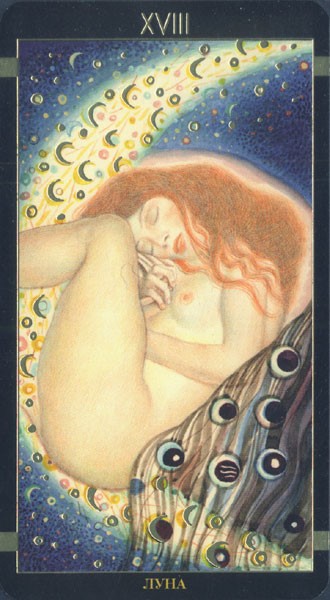
Danae - The Moon
In the painting, a golden river falls between her legs, by which she got pregnant and gave life to Perseus. Danae is on a clear colored background, alike an uterus becoming progressively narrower at the lower area, ending like the exit from a womb. The painting inspired card XVIII Moon, in which the river follows the path of the classic waxing Moon pattern of the card, although dismisses the physical birth meaning suggested by the clear shape in the painting.
During the same year, Ferdinand Bloch-Bauer, a wealthy businessman who had prospered in the sugar industry and supported Klimt's artworks, asked him for a portrait of his wife. Contrasts and fusions in Portrait of Adele Bloch-Bauer I are quite similar to those in Fritza's painting made in the previous year.

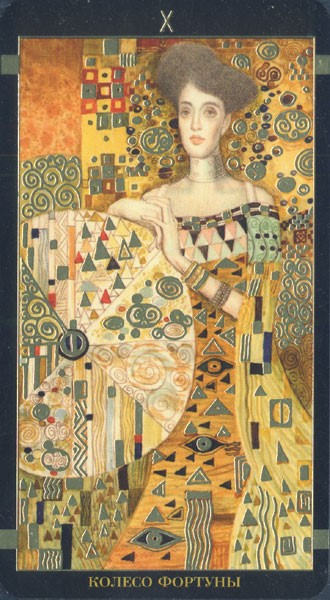
Portrait of Adele Bloch-Bauer I - The Wheel of Fortune
The figure inspired card X The Wheel of Fortune, in which she lacks of the soft traits of the painting and, instead, is depicted a bit conceited, physically elongated, forgetting some of her original warmness and spirit, and showing a strange change: her neckless lacks of the jewels Adele wears in the painting and, instead, four simple circles in her throat make not too much sense with the rest of the drawing. The wheel where she places her hands on is formed by eight sectors, two of them fused with the background, so it can be seen a figure alike the famous pacman, the video game in which the yellow drawing won by eating dots and ghosts. Fortune card, which basically has a karmic meaning in Tarot, might have been associated to that ludic reference and also to the literal wealthness of the sugar trader, in the way that Atanassov had previously associated pregnancy in Hope I to The World card.
Between 1907 and 1908, Klimt composed The kiss, the famous painting remembering the moment in which Apollo kisses Dafne the nymph before she turns into a bay tree. Both of them had been reached by Eros' arrows, the god of love, although Apollo's arrow was made of gold, whereas Dafne's was made of lead, which made her reject him.


The kiss - The Lovers
Both figures are on the edge of a flourished field, wearing contrasting clothes: the man in a tunic of irregular rectangles, the woman in a tight dress of oval stamps. The composition is reflected in card VI The Lovers. And, like in the painting, both dresses are fused with the golden wrapping background.
Finished in 1907, Water Serpents I was one of the few paintings made in watercolor and tempera (Klimt mostly used oils). Of very small dimensions (19.6" x 7.8"), it displays two embraced figures (not necessarily both women) usually appreciated inside of a lesbian scene, although half-nudes in overlapped and entangled bodies are a constant in Klimt's works, so the painting may not necessarily have a sexual basic meaning. Gold leaves clearly add a 3D effect to a composition that includes a big-head fish on the figures' feet: the extremes remain connected to each other, which is a classic meaning of the serpent as an esoteric symbol.

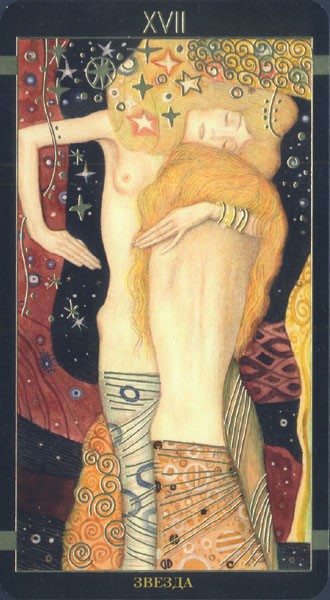
Water Serpents I - The Star
The painting inspired card XVII The Star although the sea environment is replaced by a sky background, with stars mostly spread in the superior area. The replacement makes the two figures stand up, and the sky remains behind them. So the serpents easily acquire the classic sexual connotation of the common appreciation. Inserting, changing or removing elements by choosing a sexual understanding produces radical changes in symbolic and aesthetic appreciations. Why did Atanassov choose the painting to illustrate the card? It's a mystery since The Star emerges after a deep mature experience, of transcendental processing usually represented by a single figure, as an individual consciousness, who goes beyond Earth from her ancient water origin, undifferentiated, astral in only an emotional sense (literal!). Maybe Klimt represented transcendence as the union of two serpents, Life synthesis! But that could be an option in Klimt's painting, not in Atanassov's illustration.
 Klimt made two versions of Judith's story as told by the Ancient Testament, one in 1901 and the other one in 1909. Judith was a Jew from Simeon's tribe, widow of Manases and living in Betulia, a city surrounded by the army of Holofernes the Asyrian general, who had been sent there by order of Nabucodonosor the Babilonian king. Judith found the way to enter the general's campaign tent, and then cut his head off. After the murder, the Asyrian army run away and was defeated. The painting from 1901 depicts her as a very sensual and carnal 3D figure, in contrast with bidimensional clothes and a plain background, whereas Holofernes' head is partially displayed in the inferior right corner. But Atanassov chose the 1909 version, of adorned decadence and death, to illustrate card XI Strength.
Klimt made two versions of Judith's story as told by the Ancient Testament, one in 1901 and the other one in 1909. Judith was a Jew from Simeon's tribe, widow of Manases and living in Betulia, a city surrounded by the army of Holofernes the Asyrian general, who had been sent there by order of Nabucodonosor the Babilonian king. Judith found the way to enter the general's campaign tent, and then cut his head off. After the murder, the Asyrian army run away and was defeated. The painting from 1901 depicts her as a very sensual and carnal 3D figure, in contrast with bidimensional clothes and a plain background, whereas Holofernes' head is partially displayed in the inferior right corner. But Atanassov chose the 1909 version, of adorned decadence and death, to illustrate card XI Strength.


Judith II - Strength
In Judith II, the figure remains narrowed among frames, with crisped hands as claws although wearing bracelets in her wrists. The murder as such becomes relevant, since Holofernes is a much more present figure if compared to the previous version. Besides, the card includes adorned frames, and Judith shows that fixed and rigid expression suggested by Atanassov's persistent closed lips.
In Death and Life (1910), Klimt represented the Grim Reaper as an elongated skeleton covered by a blue and purple tunic, full of crosses. The character holds a little gnarled club, and looks at Life with its eternal smile. Life is on the right, characterized by several figures, some of them naked and some others half dressed up, intertwined and of different ages. The painting was the reference for illustrating card XIII Death.

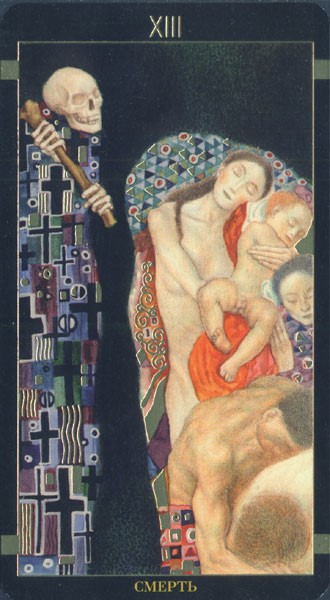
Death and Life - Death
Near his death hour, Klimt painted Adam and Eve (1917-18), in a quite sensual and sexual scene. The painting inspired card XIV Temperance, although the latter includes an apple (a forbidden symbol) and the figure accordingly lacks of the voluptuous shapes and pleasant expressions of the painting.


Adam and Eve - Temperance
This way to represent the card's motif is quite singular, since the poured liquid doesn't flow from vessel to vessel and, instead, just fills up a head lying on the floor. A first impression of Atanassov's illustration is the head seemingly hanging from Eve's hand, which has nothing to do with the card's meaning. But other changes made by Atanassov are relevant for Tarot, since without exchanges the card misses the fruitful meaning of growth and creative potential, which only emerges by experiencing real and reciprocal interactions (with the environment, context or other people). Since the influence happens in a only-one flow direction, and touching the woman is forbidden, then balance and harmonization (which always depend on relations) don't come out as authentic experiences.
Other cards such as The Hanged Man (XII) and The Tower (XVI) might not be inspired by specific paintings although follow the same style pattern of naked decadence and accentuated traits, on fused backgrounds and a mostly 2D decoration. Whereas The Emperor (IV) resembles Pallas Athenea in a male version, and The High Priest (V) depicts Klimt's figure.

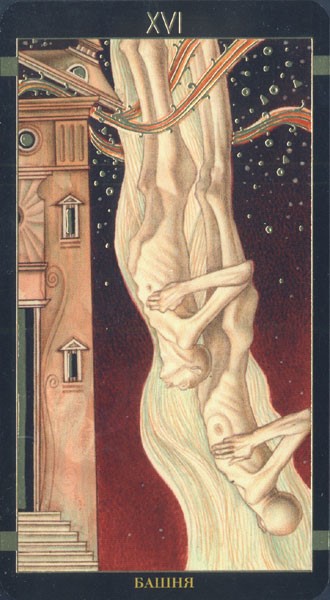
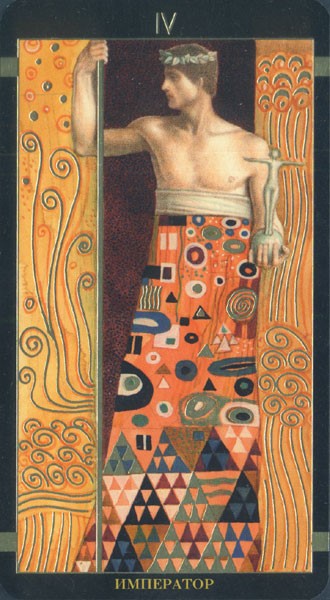
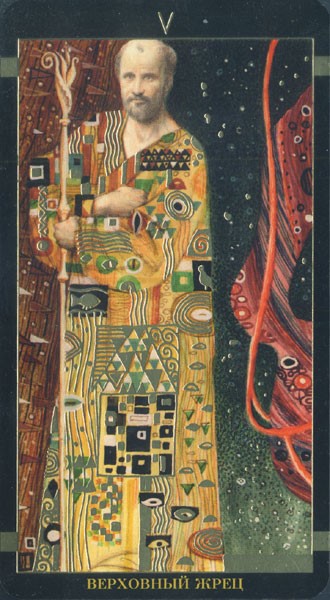
About golden leaves

Gold has been used over thousands of years, in different regions and ways, in sculptures as well as in paintings and architectural works. After the final melting of the metal, a craft hammering process or a constant roller pressure produce fine leaves, which must be handled delicately by special tools to avoid breaks. A single .19" gold nugget can be transformed into a 1.64 ft leaf.
The techniques to melt metal, produce leaves and work on the surface to be goldened, vary according to the laboral tradition and the quality of the metal. For a home and simple usage of low quality leaves, firstly the chosen surface must be varnished, waiting until is dried although sticky, so when the leaf is placed upon it, it remains attached. Then, the rests are removed and, finally, the leaf remains fixated by painting with a lac substance.
Sources: El Separatismo Vienés, Gustav Klimt, Biblioteca Nacional de Austria, Cómo aplicar pan de oro en 4 pasos.
Note: images displayed in this article might not be exact or complete reproductions of the original paintings.





Comments
Join and leave a message. I always answer personally, and as soon as possible.